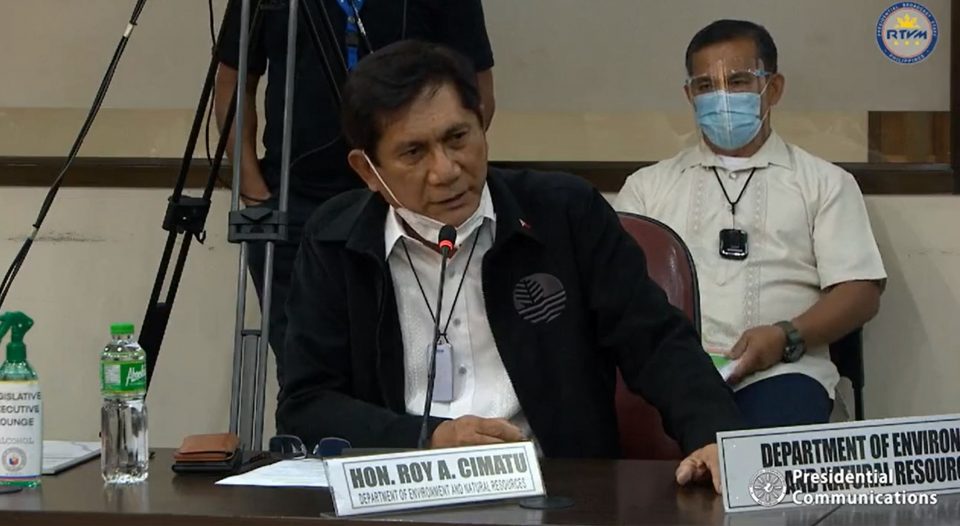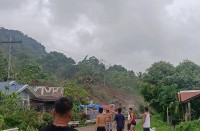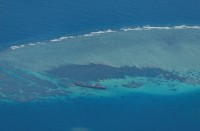DENR chief says dolomite use will even clean, nourish Manila Bay water

(Eagle News) – Environment Secretary Roy Cimatu stressed that the crushed dolomite being used to cover the baywalk area of Manila Bay does not pose any health risk to the public, but will in fact even clean the waters of Manila Bay because of its properties.
Cimatu, speaking during budget deliberations in Congress on Sept. 8, explained that the crushed dolomite used to make a “white beach” area in a part of Manila Bay is three times bigger than sand, and that the department had studied the plans very well on the use of dolomite.
“Pinag-aralan po namin talaga iyan,” Cimatu said as he explained the technical studies and other options presented on the type of sand which the Department of Environment and Natural Resources had considered to be dumped in Manila Bay.
“We are really very sure of the safety of the dolomite used in that area, your honor,” he said.
The DENR chef talked about the “beach nourishment” process where dolomite is used, as has been done for several years now in high-end beach resorts in Cebu, including in Mactan.
Cimatu stressed that there is no health risk at all to the public as the only health risk for dolomite is during the crushing process in the mining source when there are dust particles present.
-Dolomite can turn acidic water into alkaline water, says Cimatu-
But the dolomite particles being dumped in the Manila Bay area is much bigger than sand, with some particles even like small rocks. The dolomite particles will also be able to turn the acidic water into alkaline water as done in dolomite use for aquariums.
The “white beach” to be created along Manila Bay will be 120 meters long and 60 meters wide. The dirty sand had already been removed and replaced with the dolomite granules.
This white beach area will also be protected by “geotubes” explained DENR Secretary Cimatu and Undersecretary for Priority Programs Jonas Leones
“Nilalagyan po namin ng konting beach dyan. Naglagay po kami ng beach dyan na nakikita po natin ngayon,” Cimatu said.
-Dolomite used in resorts in Cebu-
He said that they chose dolomite to be used to line up the “white sand beach” area the DENR had envisioned for a portion of Manila Bay as this has also been used in other resorts in the country such as in Cebu, in the Mactan Bay area, and in Plantation Bay.
At first, they thought of lahar, he said, but this was too fine, and would be too muddy when it becomes wet. Then, the second option was sand from other nearby rivers. But the proposal for dolomite was the best option since this had been used before in resorts, and have posed no danger at all to the public.
“May nagsabi na mayroong dolomite. Ito po ang ginamit nila dyan sa resort sa Mactan. Mayroon din sa Cebu. So mayroon na pong experience dyan na puedeng magamit,” Cimatu said referring to the dolomite particles to line up the Manila Bay beach area.
“Pangalawa, lilinisin rin nito ang tubig. Magbibigay ng nourishment. Tingnan po ninyo sa mga aquarium na may bato-bato. That is dolomite, lilinisin po niya ang tubig na ito. From acidic magiging alkaline po ito,” the DENR chief explained. He even brought a dolomite particle used in aquariums to show to Congress.
-Health risk is during crushing process at mining site-
If there is a harmful effect regarding dolomite, it is during the crushing process at the source, or in the mining area, he said.
“May harmful effect kung kina-crush yan, doon sa source of mining area. Kung wala kang protection dyan ay harmful po yan kasi nandyan po yang mga dust particles, yung silica, kasama sa component ng dolomite,” Cimatu said.
There are two main chemical components: calcium which is about 75 percent, and magnesium which is around 23 percent of dolomite, and the rest are small chemical components.
“Pinili namin yung biggest size. Bigger than sand. So mas malalaki. Yan na po ang binubuhos doon,” Cimatu said referring to the crushed dolomite placed in the Manila Bay.
“Ginagamit po ito since 1996 po ito para po sa beach nourishment sa Mactan, Cebu. Wala naman po kaming nabasa, na nagka-problema. Ginamit din sa public beach ito doon. So ito ang aking sagot doon sa concerns na this is harmful,” Cimatu said.
-DENR study on dolomite-
He also cited the study by the DENR’s Mines and Geosciences bureau that said that it is the dust particles during the crushing of dolomite at the source which is harmful if inhaled. These dust particles are 10 to 15 microns in size.
But the dolomite particles being dumped in Manila Bay are 2 to 5 five millimeters in size, which is 2,000 to 5,000 microns in size, definitely much much bigger than dust particles, Cimatu explained as he read the findings of the DENR’s bureau study to contradict earlier statements from Health Undersecretary Maria Rosario Vergeire that claimed dolomite poses a health hazard.
Later, the DOH’s Vergeire also clarified that it is during the crushing process of dolomite, where there is a health hazard for dolomite dust particles.
“Dolomite in its natural state is not a known health hazard. It is not listed by the Mines Safety and Health Association, Occupational Safety and Health Association, and even in the International Agency for Research of Cancer as a carcinogen,” Cimatu told lawmakers during the DENR’s budget deliberations.
“What is hazardous is the fine silica quartz in some dolomite in the form of dust that is generated during the crushing and screening, not the calcium and magnesium,” Cimatu said reading a part of the DENR study on dolomite.
Informed about some senators’ moves to have the use of dolomite in the Manila Bay baywalk area to be stopped, Cimatu categorically stated again that the dolomite the DENR is using is not hazardous to health.
“Kung kailangan pong magpaliwanag po kami sa Senate, ay gagawin po namin ito,” he said.
-Tons of garbage removed from Manila Bay-
The DENR chief also explained that before dumping the crushed dolomite in Manila Bay, the department had already removed tons of garbage from the area.
In fact, the DENR continues its clean-up of Manila Bay, scraping even the bottom sands in the bay where tons of garbage had been lodged for years.
They are also cleaning up all of the esteros leading to the bay, and the other tributaries, as well.
During low tide, the “white beach” in Manila Bay will be seen in the area. There are also geotubes placed along the shoreline to hold the sand, so this won’t be washed away by the water or waves.
He said that on Sept. 19, the white beach area will be opened to the public, in time for the International Coastal Cleanup Day.
(Eagle News Service)








